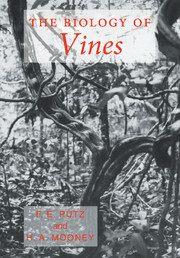Book contents
- Frontmatter
- Contents
- List of contributors
- Foreword
- Preface
- Acknowledgements
- I INTRODUCTION
- II CLIMBING MECHANICS AND STEM FORM
- III VINE PHYSIOLOGY AND DEVELOPMENT
- 5 Water flux and xylem structure in vines
- 6 Reserve economy of vines
- 7 Photosynthesis and gas exchange of vines
- 8 Heteroblastic development in vines
- 9 Physiological ecology of mesic, temperate woody vines
- 10 Secondary compounds in vines with an emphasis on those with defensive functions
- IV COMMUNITY ECOLOGY OF VINES
- V ECONOMIC IMPORTANCE OF VINES
- Taxonomic index
- General index
7 - Photosynthesis and gas exchange of vines
Published online by Cambridge University Press: 05 November 2011
- Frontmatter
- Contents
- List of contributors
- Foreword
- Preface
- Acknowledgements
- I INTRODUCTION
- II CLIMBING MECHANICS AND STEM FORM
- III VINE PHYSIOLOGY AND DEVELOPMENT
- 5 Water flux and xylem structure in vines
- 6 Reserve economy of vines
- 7 Photosynthesis and gas exchange of vines
- 8 Heteroblastic development in vines
- 9 Physiological ecology of mesic, temperate woody vines
- 10 Secondary compounds in vines with an emphasis on those with defensive functions
- IV COMMUNITY ECOLOGY OF VINES
- V ECONOMIC IMPORTANCE OF VINES
- Taxonomic index
- General index
Summary
Introduction
Vines allocate proportionally larger amounts of biomass to photosynthetic biomass than do self-supporting plants (Suzuki, 1987). Most forest vines have been described as ‘light hungry’ (Putz, 1984) and, in reaching for high light environments on top of the canopy, and at their edges, vines have developed a variety of climbing systems and associated characteristics (Schenck, 1892; Castellanos et al., 1989). Climbing in vines is mainly constrained by support availability (Putz, 1983, 1984; Teramura, Gold & Forseth, Chapter 9), attachment success to the substrate (Peñalosa, 1982; Putz & Holbrook, Chapter 3) and, as a consequence of support attachment, by light availability.
Although ubiquitous in most communities worldwide, vines in general are most strongly represented within highly heterogeneous light habitats (Caballe, 1984). Vines have developed several strategies for ‘foraging’ for light and support, growing horizontally and vertically across varying levels of resource availability (Peñalosa, 1983; Putz, 1984). As such, vines may represent the end-point in a series of growth forms adapted to exploit extensive horizontal and vertical above-ground space volumes, without being dimensionally limited by root ‘foraging’ sites as in the case of clonal (stoloniferous or rhizomatous) species (Harper & Bell, 1979; Bell, 1984; Slade & Hutchings, 1987).
Exploitation of sites varying greatly in light and other available resources may be enhanced in vines by combining a number of physiological and morphological traits in their leaves.
- Type
- Chapter
- Information
- The Biology of Vines , pp. 181 - 204Publisher: Cambridge University PressPrint publication year: 1992
- 2
- Cited by

